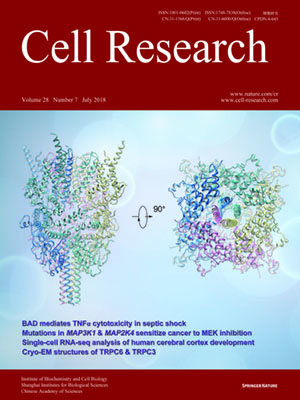
Volume 28, No 7, Jul 2018
ISSN: 1001-0602
EISSN: 1748-7838 2018
impact factor 17.848*
(Clarivate Analytics, 2019)
Volume 28 Issue 7, July 2018: 701-718 | Open Access
ORIGINAL ARTICLES
The BH3-only protein BAD mediates TNFα cytotoxicity
despite concurrent activation of IKK and NF-κB in septic
shock
Jie Yan 1,2, Hao Zhang 3, Jialing Xiang 4, Yu Zhao 4, Xiang Yuan 1,3 , Beicheng Sun 5 and Anning Lin 1,2
1Ben May Department for Cancer Research, The University of Chicago, Chicago, IL 60637, USA; 2The Second Affiliated Hospital, The State Key Laboratory of Respiratory Disease,
Guangdong Provincial Key Laboratory of Allery & Clinical Immunology, Guangzhou Medical University, Guangzhou, Guangdong 510260, China; 3The State Key Laboratory of Cell Biology, CAS Center for Excellence in Molecular Cell Science, Shanghai Institute of Biochemistry and Cell Biology, Chinese Academy of Sciences, University of Chinese Academy of Sciences, Shanghai 200031, China; 4Department of Biology, Illinois Institute of Technology, Chicago, IL 60616, USA and 5Department of Hepatobiliary Surgery, The Affiliated Drum Tower Hospital of Nanjing University Medical School, Nanjing, China
Correspondence: Correspondence: Anning Lin (anninglin@bsd.uchicago.edu)These authors contributed equally: Jie Yan, Hao Zhang
The inflammatory cytokine TNFα plays a crucial role in the pathology of many inflammatory and infectious diseases. However, the mechanism underlying TNFα cytotoxicity in these diseases is incompletely understood. Here we report that the pro-apoptotic BCL-2 family member BAD mediates TNFα cytotoxicity despite concurrent activation of IKK and NF-κB in vitro by inducing apoptosis in cultured cells and in vivo by eliciting tissue damage of multiple organs and contributing to mortality in septic shock. At high doses, TNFα significantly inactivates RhoA through activation of the Src-p190GAP pathway, resulting in massive actin stress fiber destabilization, followed by substantial BAD release from the cytoskeleton to the cytosol. Under this condition, activated IKK fails to phosphorylate all cytosolic BAD, allowing translocation of non-phosphorylated BAD to mitochondria to trigger apoptosis. Polymicrobial infection utilizes the same mechanism as high-dose TNFα to elicit apoptosis-associated tissue damage of multiple organs. Consequently, loss of Bad or elimination of BAD pro-apoptotic activity protects mice from tissue damage of multiple organs and reduces mortality rates. Our results support a model in which BAD mediates TNFα cytotoxicity despite concurrent activation of the IKK-NF-κB pathway in cultured mammalian cells and in septic shock.
https://doi.org/10.1038/s41422-018-0041-7
FULL TEXT | PDF
Browse 1792


